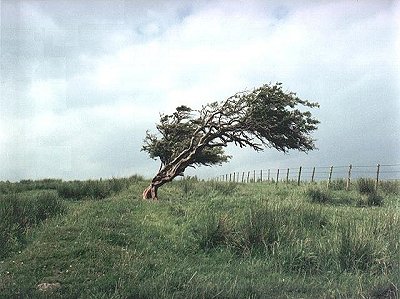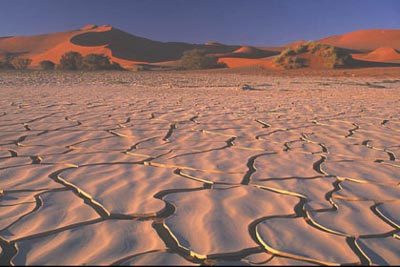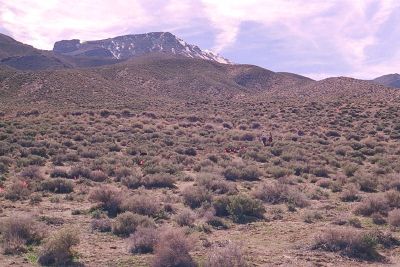Geothermal: Stealth Renewable
Have you ever wondered why geothermal goes so incognito when the renewable electricity market is so visible? There could be a number of reasons, but we believe it has to do with accessibility to the public and ease of identifying resources.

Photo Credit The Pennine Way
When a lay-person sees the tree above, they can easily posit that wind contributed to the unique shape of the tree. And, since we know generally how trees grow, it’s easy to deduce that there is strong, consistent wind current present in that area. Thus, when people think about wind as a renewable resource, it’s accessible. There is no magic: wind exists and like a child’s pinwheel, it can cause things to move which is sufficient to make the connection.

Photo Credit The Safari Company
When a lay-person sees the photo above, they can reason that it is dry and that it’s likely that the sun shines there on a routine basis and rain/cloud cover aren’t the norm for the region. The connection between a strong sun presence and the potential for energy is very clear to humans, it’s accessible.

Photo Credit: UNR
Now contrast the image above with the tree and desert. What do you observe about the physical characteristics of this land? Does it look like this might be a place one could harness natural resources to generate renewable electricity? This photo happens to be from Nevada’s Dixie Valley, a known geothermal resource area. There is a functioning 60MW geothermal plant in close proximity. The only surface manifestations of the energy potential are hot springs. It’s much less accessible to a lay-person thinking about hot, fractured rocks with super-critical heated water trapped under a cap rock waiting to escape. Can you visualize it? Unless you’ve been around the industry or have a geology background, the chances are that it’s tough to comprehend.
The journal Live Science took a page from VH1’s “Where are they now?” publishing an article on “Whatever happened to Geothermal?” It’s an interesting article and covers many of the issues. Given that geothermal is the only baseload renewable power source (yes gravity hydro is close, but until droughts are solved, it’s not quite baseload) it seems inevitable that geothermal will be “rediscovered” as an energy source.









“Whatever happend to geothermal” has a few factual errors, and is actually pretty poorly written. The author seems to have misunderstood some of those he interviewed.
The Geysers in Northern California did NOT shut down in 1989. Yes, the steam was nearly tapped out, but then the power projects generated power using hot water, like most of the other geothermal projects in the world. Rewatering projects are bringing back the steam.
Five megawatts is not the “normal” capacity of a geothermal project. The flow rate and temperture of the geothermal fluid generally dictates the size of a resource, as do the financing terms.
The CO2 from geothermal come only from “flash” plants that take the hot water and allow it to boil in the turbine to generate steam. The fluids lost to the atmosphere provide the path for the CO2 escape. Most recent project, however, use closed-loop binary heat exchange technology, which returns the geothermal fluid to the ground, taking its dissolved gases, including CO2, with it.
Even so, flash plants on average release 35 times less CO2 than newer coal-fired plants, and about 14 times less than natural-gas-fired plants.
Most geothermal project use hot water, not sream, from underground. Steam-dominated resources are rare.
Most of the world’s geothermal projects are NOT in volcanically active places. Its more like 50-50, half near volcanoes, the other half where the crust is thin. The very productive Imperial Valley, California, region is basically from tectonic plate spreading that thins the crust. All geothermal in Nevada and Utah is in Basin and Range terrain, where the custs spreads and thins.
I could go on, but i’ve got to do work that I get paid for now.
Thanks for commenting Rick, we weren’t endorsing the content of the Live Science article wholesale. We merely reference it as evidence that geothermal will be “rediscovered” at some point during this bubble.
No, I knew you weren’t endorsing it. It’s just that for some reason this article is showing up mostly in places that don’t allow comments, so I was getting a bit frustrated.
This same writer does decent enough space reporting, but his foray into the earth sciences left much to be desired. The comments by Roy Baria, though, were well presented.
Rick, thanks for choosing the Renewable Energy Journal to vent. We enjoy transparent and spirited conversation.
Feel free to bomb away – we too are frustrated by the bad information being disseminated in the world. Particularly when it comes to geothermal power sources – we have an interest in clear, correct communication on the subject.